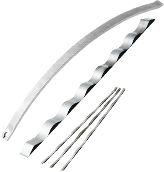Question SHINO 2006/12/11(Mon) 14:00
We are investigating the deterioration of a spring and therefore I have a question for you.
If the fatigue (plastic deformation) happens to a compression spring due to repeated loads, will the spring constant of that spring change? When the permanent deformation happens, of course, the natural length of the spring changes, but at the same time, I want to know whether the metal also hardens (?) and the performance of the spring changes or not. I am sorry for such a beginner’s question, I look forward to your reply.
Answer Tokai Spring 2006/12/12(Tue) 10:34
Dear SHINO
Thank you for posting!
When a spring is subjected to even one force that exceeds its elastic limit, it will sag. (Permanent deformation)
This is the case when a spring sags due to setting, etc. In general, this elastic limit has a certain relationship to the tensile strength of the material, and the extent to which it can be compressed before it sags can be calculated to some extent based on the material and dimensions.
However, the spring constant does not fundamentally change.
When this sag occurs, the natural length will eventually become shorter, and the spring will eventually become unusable.
* Setting: In the final step of the spring making process, high stress over the elastic limit of the material is applied to the direction of use for the spring that has been molded and heat treated. A type of plastic working.
Answer Yuki 2018/11/22(Thu) 21:47
Will a spring continue to stretch forever if more and more weight is hung from it?
Answer Tokai Spring 2018/11/23(Fri) 9:05
Dear Yuki
Thank you for your question!
If you add more weight, the spring will stretch up to the weight it can withstand,
but if you exceed that limit, it will sag and break.
It may be difficult for a spring to keep stretching forever.
We recommend that you determine the maximum weight in advance and design a spring that can withstand that weight!
Answer わらび餅 2019/6/11(Tue) 19:51
Nice to meet you, Banetto kun (* ^ _ ^ *)
I have two questions about springs.
(Question 1) Is it possible to request the spring constant when making a prototype spring, such as “Please make a spring with a spring constant of 10 N / mm”?
(Question 2) How long can a spring be used for, provided that its operation does not exceed the elastic limit of that spring? For example, at the time of designing, is it possible to know how many times a spring in a ballpoint pen will be damaged when it is clicked? Sorry for any inconvenience caused.
It would be appreciated if you could answer to even a Spring Newbie like me (* ^ _ ^ *) Thank you!
Answer Tokai Spring 2019/6/12(Wed) 10:53
Thank you for your inquiry, Warabi Mochi! !
We are happy to answer your questions!
Question 1 If you specify the spring constant, the spring shape will be designed accordingly. At that time, in addition to the spring constant, if you can provide information about the size of the spring and the mounting space, it will be helpful to determine the shape.
Question 2 The durability when using a spring can be evaluated by the torsional shear stress of the spring against repeated movements at the design stage, as long as the elasticity limit of the spring is not exceeded. The evaluation standard changes depending on the material strength, but it can be estimated if the compression amount of the spring due to the repeated movement of the ballpoint pen is known.
Thanks again for your question!
Answer Anonymous 2019/7/19(Fri) 11:19
I used ten springs in the allowable range (the free height of the springs is 40 mm, the springs are normally compressed for 7.4 mm). There are no particular changes in the number of springs used but only one piece out of ten was 20% weaker than a new spring (from 240N down to about 195N) and the length decreased by 0.1mm. Even if the length decrease is not that big, do the compression force and spring constant change? I didn’t use them at extremely high temperatures, and I didn’t see any rust or cracks. I can only think of a reason is that a malfunctioning spring was mixed into this spring lot. Could you please tell me other reasons for fatigue while there is no plastic deformation? Thank you very much.
Answer Tokai Spring 2019/7/23(Tue) 15:30
Thank you for your inquiry, Spring Newbie!
If the elasticity of only one of the ten springs is significantly reduced, something might have gone wrong even if they were all used in the same environment and under the same conditions. I do not have the information about the material, but it may be caused by heat treatment failure, for example. For spring steel, not to mention quenching and tempering, of course, for SUS type, low-temperature annealing is not applied. However, plastic deformation occurs in both cases. What is worrisome is that the spring height only reduced by 0.1 mm. However, if the spring constant is 450 N/mm, it is still acceptable… While fatigue and deformation do not happen, the change in the load characteristics will lead to the change in the elastic modulus but there is no temperature change, in this case, I can not give you a specific answer… If we can verify the spring, we may be able to identify the cause.
Once again, thank you for your inquiry!
We are happy to answer any inquiries regarding technology, specifications, materials, etc. Please feel free to ask.

















